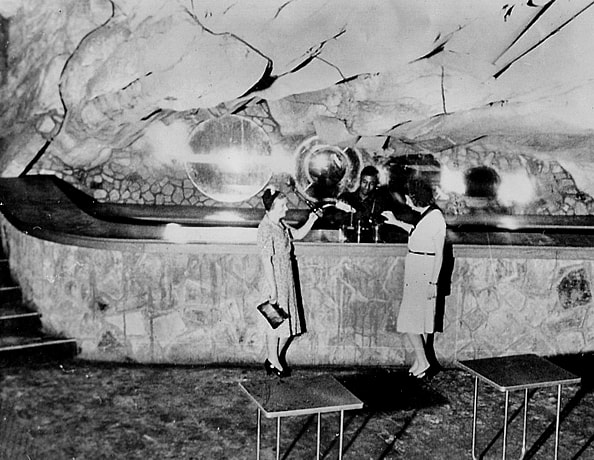 Bangor Cave, ca. 1930 (Courtesy Blount County Memorial Museum)
Bangor Cave, ca. 1930 (Courtesy Blount County Memorial Museum)
"Hitting with a bang that reverberated over the entire state, our new sheriff, Ed Miller, raided Bangor Cave on Saturday night just after the clock had passed the midnight hour and made a haul not only in gaming tables, but in arrests and drinks that make wild men wilder," was how a Blount County newspaper reported an August 1937 raid on the county's infamous speakeasy. The August raid was neither the first nor the last on the Bangor Cave Club during its short existence. During the last half of the nineteenth century, picnickers would ride in wagons or horse-drawn carriages down the dirt-packed roads that led from Blount Springs' resort hotel to Bangor Cave for picnics and romantic escapades. The cave had been discovered earlier in the century by state geologist Walter B. Jones and was a popular spot for local political rallies and Fourth of July celebrations. Concerts held within the cavern required members of the audiences to use candles and lanterns for light. But after the hotel burned in the early years of the twentieth century, the cave no longer attracted much attention and soon became little more than a local legend.
Nearly a quarter of a century later, while the country was in the midst of the Great Depression, J. Breck Musgrove, the owner of the cave and its surrounding property, decided to take advantage of the cave's spectacular beauty and isolation. He and a group of investors oversaw the transformation of the former picnic area into an unforgettable nightspot.
Throughout the months preceding the club's opening, Birmingham and area newspapers fueled widespread interest in the club by keeping their readers abreast of the latest additions to the no-expense-spared accoutrements. As the Birmingham News reported in a May 9, 1937, article:
America's only underground nightclub is rapidly approaching completion at Bangor Cave, noted throughout the South as a natural formation of wonder and beauty. After months of delay, the pioneers in this unique development have outmaneuvered nature to convert the recesses of Bangor Cave into a place of comfort, charm and beauty
Musgrove and his fellow investors spent a reported seventy thousand dollars preparing the cave for its conversion from a family-oriented destination into a subterranean dining and dance club. There are no estimates on the cost of fitting out the private and highly illegal mini-casino hidden behind a padlocked door at the end of a narrow passageway lined with armed guards in one of the cave's upper rooms.
Bangor Cave was actually a series of seven caverns, but Musgrove only used the front caverns for the club. The largest of these rooms was some 350 feet in length and 57 feet in width. The cavern's floor was covered in concrete, which was then topped by interlocking green and red tiles. Strings of rainbow-hued lights were wrapped around the column-like stalactites and inside the room's recessed areas.
An orchestra pit carved out of an enormous boulder could seat thirty musicians and vocalists, while a mammoth ledge acted as an overhang above the dance floor. A fieldstone bar backed by mirrors lined another wall. According to newspaper reports of the time, a jar filled with thousand-dollar bills was placed prominently on the bar. Individual tables lined one side of the cavernous room so diners could enjoy the dancing and floorshows. Artificial grass and flowers, something of a rarity in Depression-era Alabama, added to the club's ambience of elegance. The club also featured several anterooms and a kitchen. The small gaming room upstairs included a wall lined with slot machines and craps tables, roulette wheels, black jack tables, and other gambling equipment.
Despite the club's resounding success in its early days, or perhaps because of its triumph, Governor Bibb Graves ordered the sheriff of Blount County to close the club:
"I call your attention to the notorious dive being operated in your county at what is known as Bangor Cave. Please close this dive at once and apprehend and prosecute those guilty of law violations there."
As might be expected, the Bangor Cave Club attracted its share of confidence artists, criminals, and underworld figures. One of the club's more colorful habitués was Joseph R. Weil, "The Yellow Kid." Weil earned his nickname due to his habit of wearing only yellow clothing and driving a yellow car. He was employed as one of the casino's cashiers, and it was not until he was arrested during one of the frequent raids on the club that it was learned he was a scam artist with numerous outstanding warrants against him. Even more scandalous, rumors persist to this day that several ladies of the evening plied their trade in Bangor's less-frequented chambers.
During its short but turbulent lifespan, there would be a cyclical series of raids, closures, and re-openings. The club's doors were finally padlocked permanently in January 1939, its owners were arrested, and within the year a mysterious fire destroyed the cave's interior. But during its heyday, the club reportedly took in more than a million dollars and provided thousands of Alabamians with a taste of glamour and excitement often in short supply during the dark days of the Depression.
This feature was previously published in Issue 81, Summer 2006.
About the Author
Pam Jones is a freelance writer in Birmingham with a particular interest in criminal cases from Alabama’s past.
 RSS Feed
RSS Feed